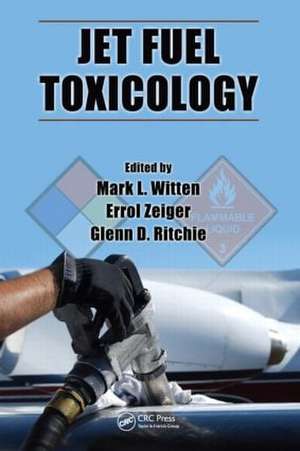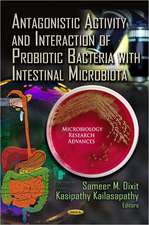Jet Fuel Toxicology
Editat de Mark L. Witten, Errol Zeiger, Glenn David Ritchieen Limba Engleză Hardback – 30 iul 2010
Due to its widespread use, jet fuel is thought to be the largest toxicant exposure risk for U.S. Armed Services personnel. Taking a proactive approach to the potential dangers of repeated human exposure to hydrocarbon fuels, the Air Force Office of Scientific Research (AFOSR) sponsored a number of research projects during the last 20 years investigating health effects resulting from specific exposure to JP-8 (Jet Propellant-8).
Jet Fuel Toxicology summarizes the newest and most important results of these extensive research programs carried out by hydrocarbon fuel research groups throughout the U.S. Each book chapter highlights one specific research area from the many topical areas comprising jet fuel toxicology. After examining the contents and general action of JP-8, the book looks at how the fuel affects various body functions highlighted by:
- Effects on daily inhalation on the respiratory system
- Acute and long-term neurotoxicological and neurobehavioral effects
- Both local and systemic toxicity following exposure through the skin
- Immunotoxicity from pulmonary and dermal exposures
- Genetic damage, as evidenced in studies of the blood and bone marrow of mice
In all, the book considers 13 major toxicology areas of study, the results of which will enable all of the hydrocarbon industry to make
| Toate formatele și edițiile | Preț | Express |
|---|---|---|
| Paperback (1) | 489.26 lei 6-8 săpt. | |
| CRC Press – 19 sep 2019 | 489.26 lei 6-8 săpt. | |
| Hardback (1) | 1187.79 lei 6-8 săpt. | |
| CRC Press – 30 iul 2010 | 1187.79 lei 6-8 săpt. |
Preț: 1187.79 lei
Preț vechi: 1596.20 lei
-26% Nou
Puncte Express: 1782
Preț estimativ în valută:
227.31€ • 236.44$ • 187.66£
227.31€ • 236.44$ • 187.66£
Carte tipărită la comandă
Livrare economică 12-26 aprilie
Preluare comenzi: 021 569.72.76
Specificații
ISBN-13: 9781420080209
ISBN-10: 1420080202
Pagini: 340
Ilustrații: 75 b/w images and 51 tables
Dimensiuni: 156 x 234 x 23 mm
Greutate: 0.79 kg
Ediția:New.
Editura: CRC Press
Colecția CRC Press
ISBN-10: 1420080202
Pagini: 340
Ilustrații: 75 b/w images and 51 tables
Dimensiuni: 156 x 234 x 23 mm
Greutate: 0.79 kg
Ediția:New.
Editura: CRC Press
Colecția CRC Press
Public țintă
Professional ReferenceCuprins
Air Force-Related Jet Fuel Toxicology Research (1991–2010). Jet Fuel Composition. The Toxicity and Underlying Mechanism of Jet Propulsion Fuel-8 on the Respiratory System.Neurotoxicological and Neurobehavioral Effects from Exposure to Jet Fuels.Differential Protein Expression Following JP-8 Jet Fuel Exposure,Immune Modulation by Dermal Exposure to Jet Fuel. Absorption, Penetration, and Cutaneous Toxicity of Jet Fuels and Hydrocarbon Components. Methods of Assessing Skin Irritation and Sensitization of Jet Fuels. Understanding Systemic and Local Toxicity of JP-8 after Cutaneous Exposures. The Effects of Aerosolized JP-8 Jet Fuel Exposure on the Immune System: A Review. The Involvement of Poly(ADP-ribosyl)ation in Defense against JP-8 Jet Fuel and Other Chemical Toxicants. Evaluation of Methods Used to Generate and Characterize Jet Fuel Vapor and Aerosol for Inhalation Toxicology Studies. Genetic Damage in the Blood and Bone Marrow of Mice Treated with JP-8 Jet Fuel. Computational Analyses of JP-8 Fuel Droplet and Vapor Depositions in Human Upper Airway Models. Human Exposure to Jet Propellant-8.
Notă biografică
Mark L. Witten, Errol Zeiger, Glenn D. Ritchie
Descriere
Currently serving as a resource for the National Center for Toxological Research in their work with the Gulf Coast oil spill, this book presents current research conducted primarily by the airforce on the toxic effects of JP-8 jet fuel on the pulmonary, immune, dermal, and nervous systems. It examines the history and chemistry involved with the handling of jet fuel, and discusses the impact of exposure. In all, the book considers 13 toxicology studies of significance, the results of which are currently shaping US armed services policy. It will enable all of the hydrocarbon industry to make better choices regarding fuel handling.












